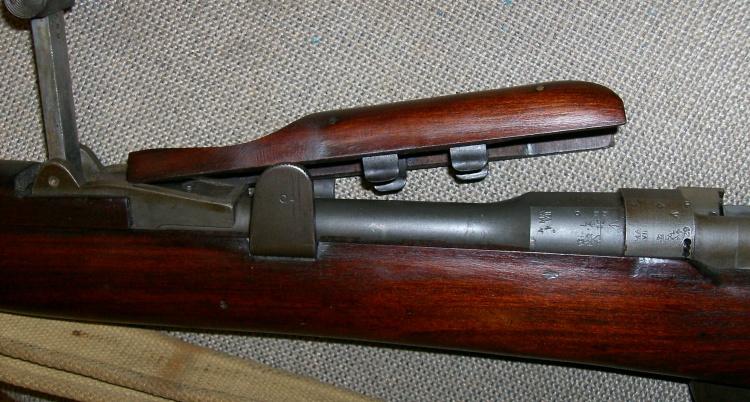-
Legacy Member

New to me SMLE No1 Mk III*---help decoding, please?
Good evening, my name is Mike and I m a brand new member here. In fact this is my first official post, other than my "introduce yourself" posting when I joined.
I recently had knee surgery and am laid up at home with lots of time on my hands and a computer in my lap. So I pulled the trigger, so to speak, and bought the above referenced rifle on an auction sight. It will join a No 4 (Savage) and a No 5 BSA Jungle Carbine in my collection. In fact, I am still awaiting shipment.In the meantime, i wanted to dig in a bit to this rifles history, and try to better understand it's life story.
What I think I know for sure is:
It is a BSA model. manufactured in 1916. It was sent to India at some point and imported to the U.S. A. by CAI.
A. by CAI.
Can you folks help me glean any additional information from the pix below? Sorry for the quality, they are from the auction sight, again, as I do t have delivery of the rifle yet.
Thanks in advance for any assistance.
Mike
Attachment 90132Attachment 90133Attachment 90131Attachment 90134Attachment 90135Attachment 90136
Information
 |
Warning: This is a relatively older thread
This discussion is older than 360 days. Some information contained in it may no longer be current. |
|
"Audacia....By daring deed"
-
-
01-19-2018 05:15 PM
# ADS
Friends and Sponsors

-
Legacy Member

Don't know if anyone will be able to tell you much more than what you have found out until you get your hands on it and get some more detailed pictures inside and out, but I am curious about that yellow stripe on the butt-stock, I remember seeing somewhere else that they had some kind of significance. She looks pretty hard-done by, but definitely still going strong if your bore is alright. Its one year older than my III* BSA!
-
-
Legacy Member

Yellow strip means downgraded to drill rifle as it’s worn but still serviceable. Keep in mind the stock could,have been changed in civilian life and it means nothing to your action. This happened to me years ago but actually worked out. I bought a Lithgow with yellow paint cheap. Took it to gunsmith to find out how worn it was and if I could shoot it. Action and bore were perfect and he surmised stock changed out. I shot it for years. Good luck.
with yellow paint cheap. Took it to gunsmith to find out how worn it was and if I could shoot it. Action and bore were perfect and he surmised stock changed out. I shot it for years. Good luck.
-
-
Legacy Member

You have a Birmingham Small Arms Co. (BSA Co.) Mk.1 No.III* Lee Enfield imported from England by (I believe) Centennial Arms Ltd. in Vermont. The upper handguards have the wooden "wings" either removed or broken off but that's not uncommon. If the numbers all match (ie: bolt, receiver, nose cap, rear sight, etc) then you have a nice collectible. In pristine condition, it would look like this.
by (I believe) Centennial Arms Ltd. in Vermont. The upper handguards have the wooden "wings" either removed or broken off but that's not uncommon. If the numbers all match (ie: bolt, receiver, nose cap, rear sight, etc) then you have a nice collectible. In pristine condition, it would look like this.
-
-
Legacy Member

P246, thanks for the great information.
Lawrence, you say "The upper hand guards have the wooden "wings" either removed or broken".....where do I see this?
Where are the "wings" located?
I tried to see the difference in the photo you provided, but it is not obvious to me.
"Audacia....By daring deed"
-
-
Legacy Member

Have a look at your photo, you can see the side of the rear sight because the wings have been cot off the upper handguard.
Dick
-
-
Contributing Member


The two top hand guards have legs that go either side of the back sight bed.
See Pic
-
-
Legacy Member

OK, I see it now. Boy, you guys have good eyes!
Why would they have been removed?
Last edited by 82Trooper; 01-20-2018 at 11:28 AM.
"Audacia....By daring deed"
-
-
Advisory Panel


Lower handguard removed to show "wings" (also visible on upper handguard, still in place).

This reminds me about a nomenclature problem that's been troubling me. In traditional usage, "upper" and "lower" are used to identify the fore and aft sections of a two-piece handguard. On the internet, I see many references to "upper" or "top" handguard for rifles (like the No.5) that have a once-piece handguard. Seems to me that just "handguard" would be sufficient for such cases.
-
-
Legacy Member


Originally Posted by
82Trooper

OK, I see it now. Boy, you guys have good eyes!
Why would they have been removed?
It was an upgrade done to stop the wood getting broken off when it snagged on equipment.
its common to find this on rifles that went through England or India after WW2 but unusual on a rifle from Australia
or India after WW2 but unusual on a rifle from Australia as the practice of chopping the wood was not adopted by the Australians
as the practice of chopping the wood was not adopted by the Australians
-
A. by CAI.















 PM
PM











